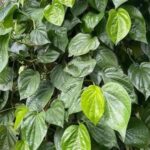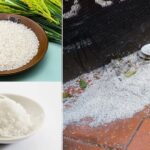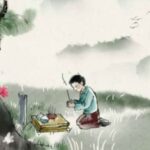The Significance of the Trio of Cups in Vietnamese Culture
The Significance of the Trio of Cups in Vietnamese Culture
In many Vietnamese households, a set of three cups is often placed on the ancestral altar, carrying profound cultural and spiritual values. This trio of cups symbolizes the piety of children towards their parents. Traditionally, when parents pass away, children observe a three-year mourning period to express gratitude for their care and upbringing.
On the altar, the central cup is offered to the deities, while the two flanking cups are dedicated to the ancestors and the deceased within the clan. These cups not only symbolize remembrance but also reflect the revered filial piety in Vietnamese culture.
Additionally, the trio of cups evokes several folk idioms and proverbs, such as “ba chìm bảy nổi” (literally, “three downs and seven ups”) or “ba đời bảy họ” (“three generations, seven families”), signifying the deep connection between generations and the gratitude towards ancestors.
The choice of three cups is also very flexible; they are usually compact, suitable for families with wall-mounted altars. Homeowners should determine the size of the altar to select ceremonial objects harmoniously and fittingly, thus demonstrating reverence and piety in the worship rituals.
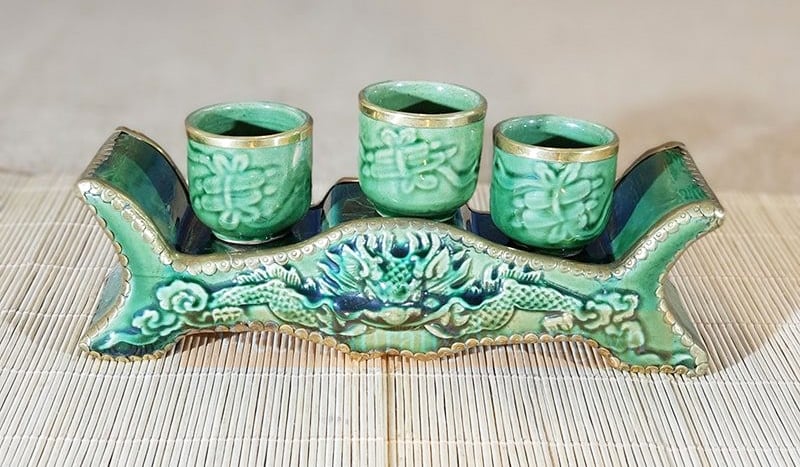
The trio of cups is a flexible choice, often compact and suitable for wall-mounted altars.
The Significance of the Quintet of Cups in Worship Culture
The quintet of cups on the altar is not just a form of worship but also carries profound spiritual meanings. The two cups on either side represent the ancestors and the deceased uncles and aunts, showing respect and remembrance. In the center, the three cups symbolize the sincerity of the homeowner towards the deities.
The number five in Vietnamese culture is not just a number; it is associated with the five elements of “Kim – Mộc – Thủy – Hỏa – Thổ” (Metal, Wood, Water, Fire, and Earth). Each element of the five phases has an influence on people’s lives and spirituality, so using the number five in worship rituals adds depth to the ceremony.
Worship with the quintet of cups is often combined with the five offerings: “Hương – Đăng – Trà – Hoa – Quả” (Incense, Oil Lamp, Tea, Flowers, and Fruits). These offerings represent completeness and the homeowner’s reverence in presenting them to the ancestors and deities, remembering the merits of the ancestors in giving birth and raising generations. This practice reflects an indispensable part of the cultural values and ethics of the Vietnamese people.
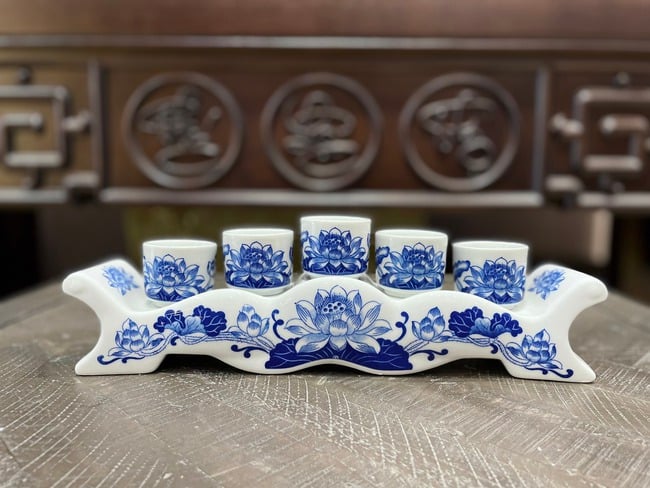
Worship with the quintet of cups is often combined with the five offerings.
Should the Altar Have Three or Five Cups: Which is the Right Choice?
When visiting various families, you will notice the diversity in altar arrangements, especially in the number of cups placed on them. Some families choose three cups, while others prefer five. This raises the question: which is the correct way?
In reality, both arrangements demonstrate the respect and sincerity of the descendants towards their ancestors. While the number five implies a sense of completion, it does not diminish the importance of the number three. Thus, both have their own significance in Vietnamese worship rituals and are not considered taboo.
The choice between three or five cups also depends on the space and arrangement of each household. For smaller altars or wall-mounted ones, using three cups often brings a sense of balance and aesthetic appropriateness.
On the other hand, in families with larger altar spaces and multiple ceremonial objects like incense burners, oil lamps, or flower vases, choosing five cups creates a sense of solemnity and symmetry in the worship area. Ultimately, the right choice lies in the sincerity and arrangement of each homeowner.
Arranging the Set of Ceremonial Cups on the Altar
Arranging the objects on the altar, especially the set of ceremonial cups, should follow certain rules to ensure aesthetics and harmony. This is not only about creating a balanced composition but also influences feng shui, bringing luck and positive energy to the family.
Traditionally, the cups should be placed in front of the incense burner and the offering tray, and they must be aligned in the center of the altar. This helps create a solemn and respectful worship space.
It is important to note that the cups should be neatly arranged and placed securely in their stands. This not only shows reverence for the ancestors but also symbolizes stability and prosperity for the family. Through this meticulous arrangement, the homeowner hopes to receive the blessings and protection of their ancestors, leading to a peaceful and happy home.
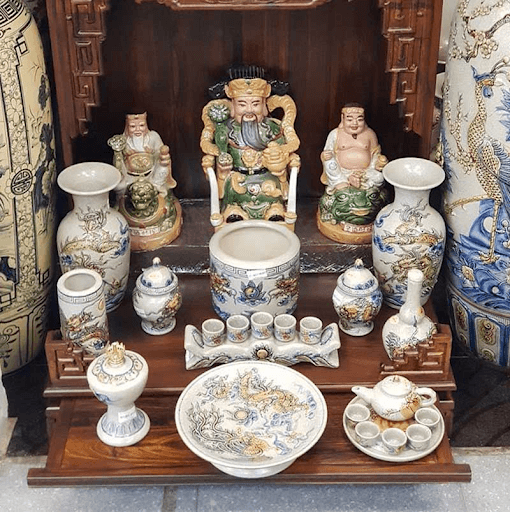
The cups should be neatly arranged and placed securely in their stands.
Guidelines for Purchasing a Set of Three or Five Ceremonial Cups for Good Fortune and Luck
Material
In the modern era, sets of three or five ceremonial cups offer a range of material choices, from earthenware, porcelain, and wood to copper and ceramic. One notable product is the Bat Trang ceramic cups, crafted intricately by skilled artisans. The patterns and colors are presented harmoniously, creating an artistic beauty.
Depending on the size and style of the altar, homeowners can choose a set that fits, whether it’s three or five cups, to create a harmonious worship space.
Design
The sets also vary in design. They can feature traditional patterns like dragons and moon faces or be left plain and simple. Each design carries its own significance and beauty:
– The “end of the letter” pattern represents knowledge and nobility.
– The moon face design symbolizes a happy and fulfilled life.
– Dragon patterns evoke a sense of awe and respect.
When choosing a set, consider the meaning and style that each design conveys to find the most suitable product.
Style
Apart from material and design, the style of the set is also crucial. The cups can be crafted in various styles, from curved sets to golden throne-like stands. This allows homeowners to choose a design that not only suits their personal taste but also harmonizes with the worship space, creating a sense of balance and solemnity for the ancestral altar.
Information is for reference only, and for personal interpretation
The Oldest Market in Hue: A 170-Year-Old Legacy That Endured Through Time
The Gia Lac market exudes a unique charm, harking back to the nostalgic scenes of a bygone Tet holiday brimming with warmth and rich cultural heritage. It is not merely a traditional marketplace but a cultural hub, seamlessly connecting the past with the present, the sellers with the buyers, and, most importantly, preserving the quintessential spiritual values of Hue.

























